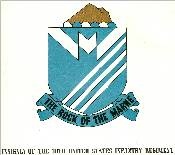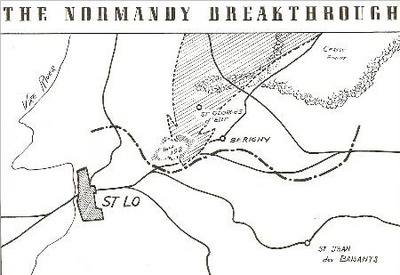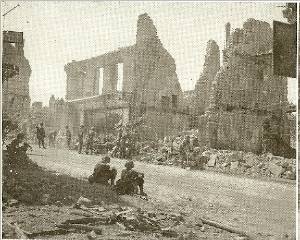
“I request every soldier to go forward to his assigned objectives with the determination that the enemy can survive only through surrender; let no foot of ground once gained by relinquished nor a single German escape through a line once established."
“With all of us resolutely performing our special tasks we can make this week a momentous one in the history of this war – a brilliant and fruitful week for us, a fateful one for the ambitions of the Nazi tyrants."
Most sincerely,
(sgd) Dwight D. Eisenhower. Although this chapter title might infer a period of swift, day advance, it is very misleading. True, during the interval 21 July to 15 August the Battalion covered considerably more ground that during the preceding period from 7 June to 21 July, this so called “Run to Tinchebray” undoubtedly gave the Battalion its most grueling physical test as well as presenting some of its bitterest combat action. It is also to be remembered that by 21 July the Battalion has suffered casualties in excess of its initial strength.
 On July 21, the 38th Infantry Regiment supported or reinforced by the 38th, 12th, and 953rd Field Artillery Battalions, Company A, and E, 741st Tank Battalion, company A, 81st Chemical Battalion was ordered to attack on 230630 B July 1944, later changed to July 26, in conjunction with the 23rd Infantry Regiment and elements of the XIX Corps.
On July 21, the 38th Infantry Regiment supported or reinforced by the 38th, 12th, and 953rd Field Artillery Battalions, Company A, and E, 741st Tank Battalion, company A, 81st Chemical Battalion was ordered to attack on 230630 B July 1944, later changed to July 26, in conjunction with the 23rd Infantry Regiment and elements of the XIX Corps.
The mission of the Regiment was to seize the high ground in the vicinity of St. Jeanese des Baisants. This attack was to be coordinated with now famous operation “Cobra”, which took place further to the west. In the Regimental order, the second battalion was to be in regimental reserve with the mission of securing the regimental right flank and to repel any counterattack from the south and west. Movement from successive positions to be on regimental order.
Early on the morning of 26 July the Battalion moved forward to its designated reserve position. However, because of the extremely tenacious resistance in front of the 1st Bn and the 102 Cav. Group, Mechanized, it was impossible for these two units to advance and because the 3rd Bn was able to make some advances, by 1210 on the 1st day of the attack the 2d Battalion was ordered from Regimental reserve to attack between the 1st and 3rd Battalion taking over the zone of the 1st Bn. Utilizing a sunken road which ran from a point just north of Le Soulieu to a position on the St. Lo road between the 1st and 3rd Bns the 2d moved in single file to an attack position from which it could fan out in its assigned zone on the right of the 3rd Bn.
During this move the enemy shelling was severe and had it not been for the protection of the sunken road our causalities would have been heavy indeed. Thus the attack of the Regiment continued through stubbornly defended hedgerow fields with the 3rd and 2nd Bn abreast. By 2150, 26 July, F Company had secured its assigned objective and G Company was echeloned to their right. At this time the welcome word “Button up for the night” came down from Regiment. At 0800 hours the next morning Companies F and G, supported by elements of the 741st Tank Bn, jumped off again for a continuation of the attack. This day’s hedgerow fighting was marked by slow steady advance, a strafing and bombing episode against Company G, and the loss of one of the oldest members of the Battalion – Captain Vincent E. Wallace, being severely wounded was succeeded in command of Company F by 1st Lt. John Dumont.
 The following day saw the 3d Bn pinched out by a shift in Regimental and Bn boundaries so that the 28th the Regimental colors were carried forward by the 1st and 2nd Bn. At 2135 the Battalion buttoned up for the night in a position south of St. Jeanne des Baisants.
The following day saw the 3d Bn pinched out by a shift in Regimental and Bn boundaries so that the 28th the Regimental colors were carried forward by the 1st and 2nd Bn. At 2135 the Battalion buttoned up for the night in a position south of St. Jeanne des Baisants.
After three days of continuous attack and advance, St Jeanne des Baissant, which from Lo Soulaire looked so far away, so calm and peaceful, now broken rubble and glowing embers was at last ours.
At 1000 hours on the morning of 29 July the Bn received orders to send out one company supported by a platoon of light tanks to act as a reconnaissance and screening force in the Regimental zone of attack. Company E, the company selected for this mission, was organized into three reinforced platoons each having orders to advance along one of three parallel routes in the Regimental zone. The remainder of the Bn was prepared to follow Company E at a time to be designated later by Regiment. By 1425 Company E had advanced approximately 2 miles and at 1500 the Battalion proper moved out from positions around St Jeanne des Baissant with the mission of securing positions in the vicinity of Torigni-Sur-Vire. The advance of the Battalion was rapid and at the end of five miles the advance guard of the Battalion was in physical contact with elements of the Regimental screening force, company E. At this moment, however, just north of Chapelle Du Fest at a point in the road where the Battalion route of advance turned sharply to the east, our easy going came to an abrupt halt.
Up ahead the “Krauts” could be seen running toward the lead elements of Company “E’s” center platoon and at the same time German artillery and beautifully concealed self-propelled guns opened up on the road we were using. This enemy action, having all the ear marks of a local counter attack, caused the battalion commander to immediately issue orders to get the battalion on to high ground just off to the left of the route of advance. In just 30 minutes the battalion moved from an advance guard formation to a deployed position ready to meet any move of the Germans, or continue the attack in a completely deployed formation. Due to the lateness of the hour and the enemy resistance which was found to extend across the entire front, the Battalion remained in its newly occupied positions for the night. A report of the situation was made to Regiment and orders were received to renew the attack in the morning. In conjunction with Impressive Blue on our right and Index on our left we jumped off at 0900, 30 July. Our attack, even though well supported as it was, soon came to a dead stop in front of the German positions which were ideally situated on a long low ridge parallel to our front behind a small stream. Moreover, the Germans that day used what was to become familiar tactics, that is, throw in all the mortar and artillery ammunition they had on position prior to pulling out.
On the 30th of July no advance on the entire Division front was made, and as was suspected, the enemy under cover of darkness withdrew further to the south. At 0800 on the 31st we took up the pursuit meeting no resistance other than a few mines, until 1650, when the leading elements of the Battalion came under fire from a newly established defensive position on high ground southwest of
Torigni-sur-Vire. This time, however, we were able to keep up the momentum of the attack and by 2400 hours the Battalion was astride its objective, the main road running southwest from Torigni. A the end of this day, the sixth of continuous offensive action, the men of the battalion were actually out on their feet from sheer physical exhaustion. But we were now able to see some of the results of this relentless attack, attack, attack.
About Dennis Blackmore

ATTENTION READERS
We See The World From All Sides and Want YOU To Be Fully InformedIn fact, intentional disinformation is a disgraceful scourge in media today. So to assuage any possible errant incorrect information posted herein, we strongly encourage you to seek corroboration from other non-VT sources before forming an educated opinion.
About VT - Policies & Disclosures - Comment Policy



